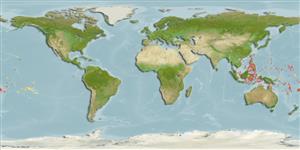>
Gobiiformes (Gobies) >
Gobiidae (Gobies) > Gobiinae
Etymology: Eviota: No etymology given, suggested by Christopher Scharpt: from Latin 'eu' for 'true' and 'iota' for anything very small, in combination 'truly very small' referring to it as being the smallest vertebrate at the time it has benn described by Jenkins (thus, making the suggestion by Scharpt plausible.; irrasa: From the Latin irrasa meaning unpolished or unshaved, in reference to the indiscrete nature of the pigmentation pattern of the head and trunk (Ref. 5289).
More on authors: Karnella & Lachner.
Environment: milieu / climate zone / depth range / distribution range
Ökologie
seewasser demersal; tiefenbereich 0 - 3 m (Ref. 58018). Tropical
Western Pacific: Cuyo Islands, Palawan, Philippines and the Southwest Islands of Palau.
Size / Gewicht / Alter
Maturity: Lm ? range ? - ? cm
Max length : 1.8 cm TL Männchen/unbestimmt; (Ref. 5289)
Kurzbeschreibung
Morphologie | Morphometrie
Rückenflossenstacheln (insgesamt): 7; Rückenflossenweichstrahlen (insgesamt): 9; Afterflossenstacheln 1; Afterflossenweichstrahlen: 8; Wirbelzahl: 26. Characterized by the following: base of pectoral fin with two dark circular to oval spots, not sharply defined and often weakly connected, the upper spot somewhat larger than the lower; pectoral spots moderately pigmented, the intensity about equal to trunk bars; head (dorsally) and nape with dark, transverse, bars continuous over dorsal midline, and somewhat more heavily pigmented laterally; trunk with regular, dark, vertical bars, somewhat diffuse in outline, continuous over dorsal midline and usually not extending below midside anteriorly and much shorter posteriorly on peduncle; scale pockets dorsolaterally on trunk often weakly pigmented (Ref. 5289); characterized further by longitudinal scale series 24; ctenoid scales, absence on head, nape and base of pectoral fin; separated pelvic fins, only thin membrane joins bases; 8-11 branches on fourth pelvic ray; depth of body 4.1-4.7 in SL (Ref. 90102). Dorsal to anal fin-ray formula 9/8 (Ref. 116739).
Life cycle and mating behavior
Geschlechtsreife | Fortpflanzung | Ablaichen | Eier | Fecundity | Larven
Karnella, S.J. and E.A. Lachner, 1981. Three new species of the Eviota epiphanes group having vertical trunk bars (Pisces: Gobiidae). Proc. Biol. Soc. Wash. 94(1):264-275. (Ref. 5289)
IUCN Rote Liste Status (Ref. 130435)
Bedrohung für Menschen
Harmless
Nutzung durch Menschen
Mehr Information
NamenSynonymeMetabolismusRäuberÖkotoxikologieFortpflanzungGeschlechtsreifeAblaichenSpawning aggregationFecundityEierEientwicklung
Alter/GrößeWachstumLänge-GewichtLänge-LängeLängenhäufigkeitenMorphometrieMorphologieLarvenLarven Pop.Dyn.RekrutierungDichteBRUVS
ReferenzenAquakulturAquakultur ProfilZuchtlinienGenetikElectrophoresesVererbbarkeitKrankheitenVerarbeitungNutrientsMass conversion
Tools
Zusatzinformationen
Download XML
Internet Quellen
Estimates based on models
Preferred temperature (Ref.
123201): 25.1 - 29.3, mean 28.5 °C (based on 1584 cells).
Phylogenetic diversity index (Ref.
82804): PD
50 = 0.5000 [Uniqueness, from 0.5 = low to 2.0 = high].
Bayesian length-weight: a=0.00708 (0.00333 - 0.01504), b=3.09 (2.92 - 3.26), in cm total length, based on LWR estimates for this (Sub)family-body shape (Ref.
93245).
Trophic level (Ref.
69278): 3.0 ±0.3 se; based on size and trophs of closest relatives
Widerstandsfähigkeit (Ref.
120179): hoch, Verdopplung der Population dauert weniger als 15 Monate. (Preliminary K or Fecundity.).
Fishing Vulnerability (Ref.
59153): Low vulnerability (10 of 100).
